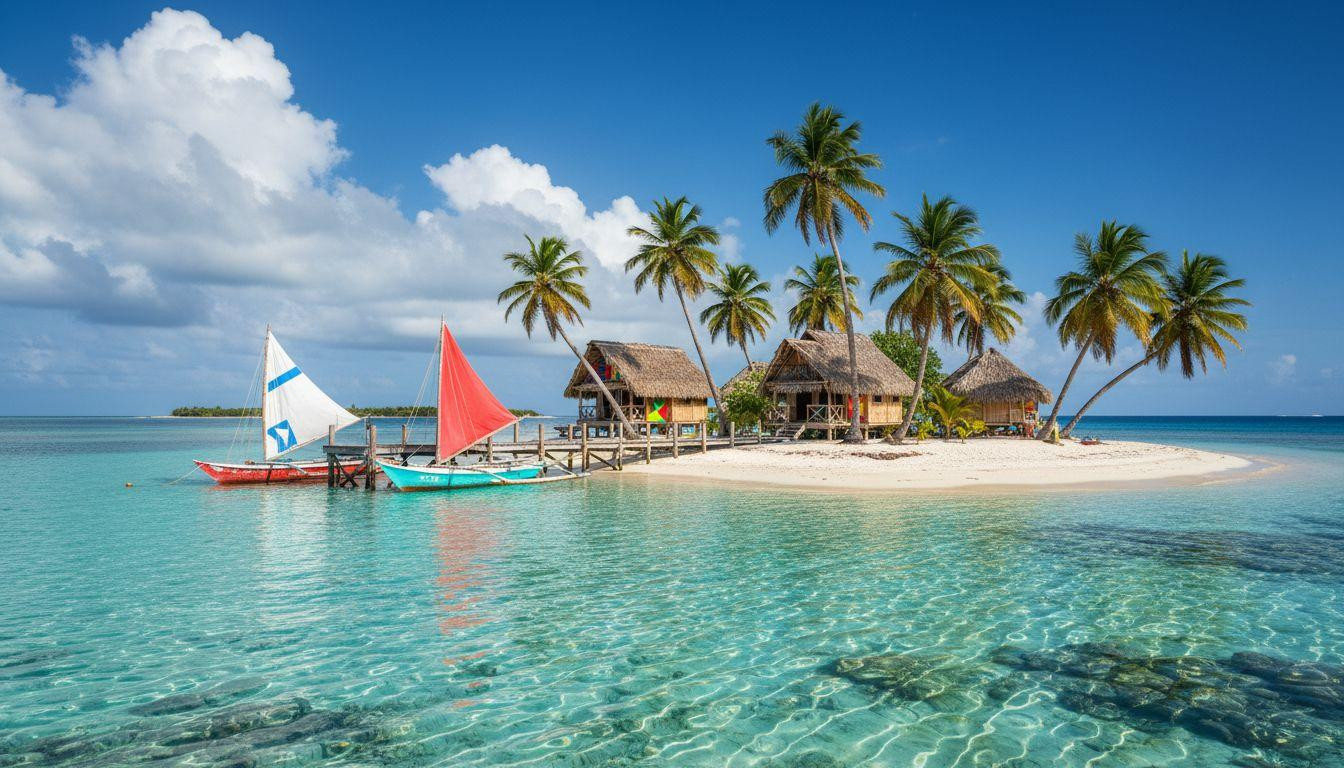The Maldives demands $800-$1,500 per night for overwater bungalows and crystal-clear lagoons. Yet nine destinations deliver identical turquoise waters, pristine coral reefs, and that floating-on-glass sensation for 40-70% less. These aren’t compromises or consolation prizes. They’re genuine alternatives where $30 buys what costs $300 in the Indian Ocean, where indigenous cultures add depth the Maldives can’t match, and where crowds disappear into endless archipelagos.
San Blas Islands, Panama: Indigenous luxury at $15 per night
The Guna Yala people govern 365 islands scattered across Caribbean waters so clear that boats appear suspended in air. Traditional overwater cabanas start at $15 nightly. Mid-range accommodations reach $140, still fraction of Maldives pricing.
Panama City sits just 5.5 hours from Miami by direct flight. Small planes connect to regional airstrips, then boats ferry visitors to isolated atolls where November brings 80-degree water and virtually no crowds. The Guna operate this tourism themselves, ensuring authentic cultural exchanges alongside world-class snorkeling.
Crystal waters meet centuries-old traditions
Water visibility reaches 100 feet during December-April dry season. Coral reefs ring every island, accessible directly from bamboo piers. Traditional sailing boats called ulus transport guests between islands, their red sails contrasting electric blue lagoons.
Mola textiles and coconut cuisine
Guna women create intricate mola fabric art, geometric patterns telling ancient stories. Fresh lobster dinners cost $7-15, served on beaches lit only by stars. Coconut rice, fried plantains, and just-caught fish define every meal.
Bocas del Toro, Panama: Afro-Caribbean soul meets overwater luxury
One hour north of San Blas, Bocas del Toro blends Afro-Caribbean culture with sophisticated eco-resorts. Punta Caracol Acqua-Lodge offers overwater bungalows at $140-300 nightly. Pacific-atoll-quality lagoons surround red-roof Caribbean towns.
Sol Bungalows launched in early 2025, featuring solar-powered overwater suites with glass floors revealing reef life below. Water temperatures hold steady at 84°F year-round. Starfish Beach and Red Frog Beach offer powdery sand and gin-clear shallows.
Reggae rhythms and conservation success
Local musicians perform on floating bars anchored in mangrove channels. Sea turtle conservation programs invite visitors to witness nesting rituals. The entire archipelago maintains a laid-back tempo that luxury resorts struggle to replicate.
Cacao farms and surf breaks
Chocolate tours explore organic cacao plantations. Fresh seafood averages $8-20 per meal. Surf breaks attract international wave riders, but most beaches remain empty even during peak December-April season.
Beyond Panama: Asia’s hidden lagoons
Mabul Island in Malaysian Borneo delivers macro-diving paradise at $30-250 nightly. Wooden chalets on stilts overlook reefs where mandarin fish dance at sunset. The Bajau sea gypsy culture adds authentic maritime traditions absent from commercial Maldives resorts.
Indonesia’s Gili Islands offer coral lagoons meeting white sand at $10-100 nightly. Raja Ampat delivers the planet’s richest marine biodiversity at homestay prices of $30-150. These destinations require longer flights from the US but reward travelers with experiences the Maldives simply cannot match.
Fiji’s celebrity-approved alternative
Marriott Momi Bay’s overwater bungalows cost $200-400 nightly versus $800-1,500 in Maldives. Direct flights from Los Angeles take just 10 hours. Coral Coast beaches stretch for miles without a single footprint.
Mexico’s freshwater marvel
Bacalar Lagoon in Mexico’s Yucatan Peninsula creates “seven colors” of blue in freshwater so clear it rivals any ocean. Boutique hotels cost $60-120 nightly. Palm-shaped islands with celebrity beach clubs pale beside Bacalar’s quiet magic.
The authentic luxury equation
These destinations deliver more than savings. They offer cultural depth the Maldives deliberately avoids. Local communities control tourism, ensuring authentic interactions over sterile resort experiences. Weather patterns favor November-April visits, perfect timing for escaping Northern Hemisphere winters.
Flight costs vary dramatically. Panama requires single connections from major US cities. Asian destinations demand 20+ hour journeys but reward with weeks-long adventures at Maldives daily rates. Mexico’s options sit just four hours from Cancun, accessible as weekend escapes.
Your questions about Maldives alternatives answered
Is water quality actually comparable to the Maldives?
Yes, scientifically verified. San Blas Islands achieve 100-foot visibility during dry season. Bocas del Toro’s lagoons test at identical clarity levels. Fiji’s coral reefs surpass Maldives biodiversity. These aren’t marketing claims but measurable water quality standards.
What about crowds and overdevelopment?
San Blas receives 30,000 annual visitors versus Maldives’ 1.7 million. Bocas del Toro maintains strict development limits. Raja Ampat purposefully restricts visitor numbers to protect reefs. Crowds remain virtually non-existent outside peak Christmas-New Year weeks.
Which destination works best for different travelers?
Couples seeking overwater romance choose Bocas del Toro or Fiji. Families prefer Bacalar’s calm lagoon and short Mexico flights. Adventure divers select Mabul or Raja Ampat. Cultural immersion travelers gravitate toward San Blas’s indigenous experiences.
Morning light filters through palm fronds onto lagoons so perfect they seem artificial. Gentle waves lap against stilted cabanas where the only sounds are tropical birds and distant laughter. This is the Maldives dream, available worldwide to those who know where to look.
